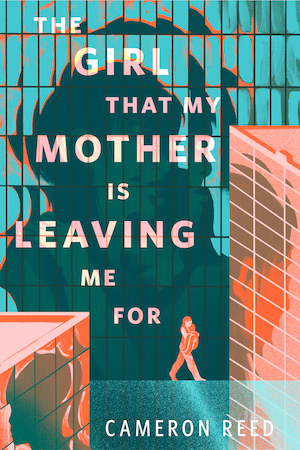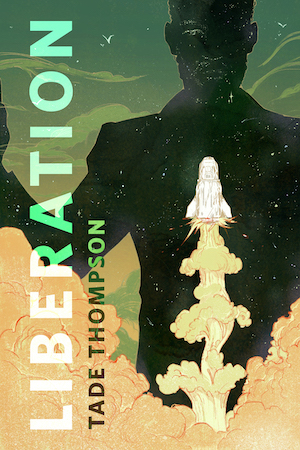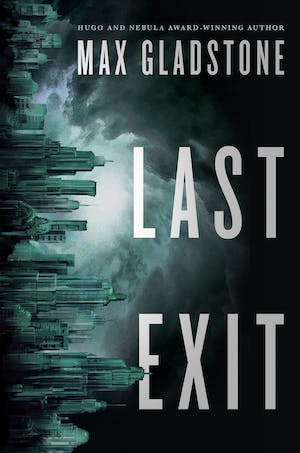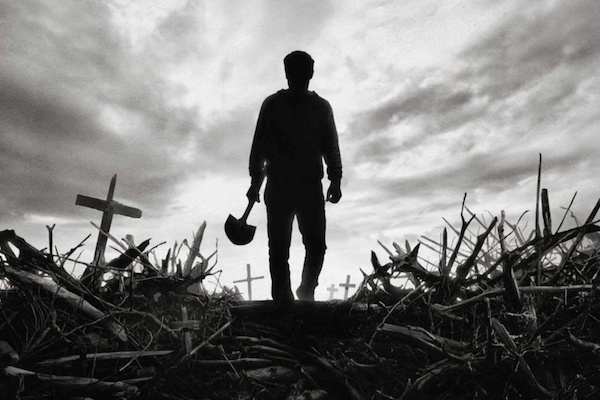Welcome back to Reading the Weird, in which we get girl cooties all over weird fiction, cosmic horror, and Lovecraftiana—from its historical roots through its most recent branches. This week, we continue Max Gladstone’s Last Exit with Chapters 7-8. The novel was first published in 2022. Spoilers ahead!
“He’d left that car wrecked and burning on a roadside in a distant impossible place, where the sky was on fire and the ground a pane of cracked glass.”
Ramon Espina considers LA “his world,” and his lover Gabe “a god in marble,” smart, a genius auto mechanic, and perfect too. Yet he’s about to leave them both, unsure when and if he’ll return.
He’s just received a letter from an old friend.
After Montana, after Zelda “lost it, and lost Sal and lost everything,” he’d drifted into a high-paid but soulless “number muncher” job and a series of dead-end relationships. Waking up one morning on the beach, with no idea how he’d gotten there, he finally went home. His uncle Tio welcomed him back to his car shop, where high-schooler Ramon had built his Challenger. That Challenger, later wrecked on Zelda’s road.
At Tio’s shop Ramon refound his mechanical skills, and met Gabe. Even knowing about “the giant Unpronounceables lurking beyond the borders of the sky,” Ramon is happy. Healed. He still has his knack of finding the way to where and what he needs: A weave through impassable LA traffic, a parking spot, a route to any goal. It’s how he uses spin.
Before leaving LA, he takes Gabe to a Dodgers game. He thinks back to arguments with Zelda about observer-dependent effects. What if, she’d said, they could use a different conceptual framework and “feed something else out into the world…”
Ramon knacks his way through surveillance cameras into the mechanical bowels of the stadium. He’s seeking his great-grandfather’s grave, here on land the city took it over for public housing, then the stadium. There wouldn’t be anything to see, but maybe he could feel something.
Gabe follows him. They find only concrete walls and warning signs. The old town’s inhabitants are utterly forgotten. Gabe senses that Ramon’s leaving. Ramon explains the promise he made when he and his friends were “a special kind of dumb.” Gabe can’t come along, but Ramon loves him and will return.
A few weeks before, Ramon acquired another black Challenger. It whispers to him that they’re “gonna ride through shit and fire to the end of the world.” And so the day after the game, Ramon drives away.
* * *
Sarah Jaye Masters is furious about “the bull-headed, blunt-minded raw Zeldaness” of the letter. Yet she knows she must leave her young children and husband Evan, her responsibilities as a physician, and why? Because Sarah’s beloved college roomie Sal is coming back.
Sarah’s relations, back on the Lakota reservation, knew the world was ending long before ever-relocated army brat Sarah figured it out. Her knack is for warding, for protecting her own from the monsters, but it hasn’t warded off Zelda’s demand. Zelda has always been stronger. Fortunately Sarah’s told Evan everything about the alt-road. Fortunately he believes her story.
She hits the road. She hates the road, because if you race along it fast enough you can avoid thinking about the history of the places you pass, about how Americans live in personal realities curated for their convenience. Zelda and the others loved the road, but Sarah only went to protect Sal.
Right now her Highlander’s on the ever-jammed D.C. Beltway, not the alt-road—or is it? Drivers in adjacent cars stare at her with unexpectedly personal enmity, and she knows once traffic starts moving, they’re going to ram into her.
It’s her phone, Sarah realizes, interfering with her spin and making her vulnerable. She steps out and throws the phone, breaking it. Things return to normal, people only glaring because she’s holding things up.
When she stops at a gas station to pick up an atlas, worse trouble finds her. The clerk has stepped out. The only other customer is a cowboy-wannabe in white Stetson hat, retracing the path she took among the shelves. On security monitors, Sarah can’t make out his, face but he leaves blood-red footprints. She runs—into the returning clerk. The cowboy vanishes.
Driving again, Sarah keeps off interstate highways. Exhausted, she stops in a state park. A young ranger knocks on the window to say she can’t stay overnight. The cowboy appears and devours the boy, the brim of his hat like some terrible maw.
Sarah escapes. On a gas station landline, she calls Evan and warns him not to use his cell phone. The hotel in Montana is her next stop. She spots a battered Subaru that might just be Zelda’s ride. In the lobby she sees Sal. No, Sal’s cousin June, grown-up. June recognizes Sarah and runs to sob in her arms. Sarah’s a doctor, right?
At Sarah’s nod, June tells her that “Z’s sick.”
Against the Rot: One of my favorite local “fights” for a better world is the creation of food forests. Our nearest is funded by the town, maintained by volunteers, and free to anyone in need of fresh fruit and nuts, native herbs, and salad greens.
The Degenerate Dutch: Sal fades from classmates’ minds—maybe magic, maybe racism. Sarah suspects the same thing will happen to her, because “whose story about the Ivy League featured a Lakota military brat on work-study who shelved books in the library three days a week?” She also shares a hint at her thoughts about Ma Tempest’s “creepy, carved, stereotype Indians.”
Weirdbuilding: Sarah’s cowboy-hatted stalker is an American myth turned gothic—rotted, even—some combination of urban legends about hook-handed mass murderers and western legends about what, exactly, goes after native Americans when they travel where they’re not “supposed to be”.
Libronomicon: Ramon’s handmade Challenger is “one of those fanged warhorses form his aunt’s far-future books, eight feet tall at the shoulder and fire-snorting, zero to sixty at the flick of the rein.” If I’m reading his aunt’s bookshelf right, with my head tilted sideways, those might be the nighthorses from C. J. Cherryh’s Rider at the Gate.
Sarah, meanwhile, takes the family to England pre-Brexit, even though it probably “wasn’t going to convulse itself into some kind of Alan Moore comic book police state”—that would be V for Vendetta on her shelf, along with the Calvin and Hobbes and Berenstain Bears series that she semi-seriously blames for her kids’ rivalries. The latter title is also well-known as a way to tell which universe you’re in.
Anne’s Commentary
With Chapters Seven and Eight, we’ve finally met all four surviving riders of the alt-roads, listened to their inner voices, and been introduced to their “knacks.” Knacks are superpowers, sort of. Super-potentials might be a better term, or maybe neither is accurate since both suggest inborn abilities or proclivities, rare and relatively straightforward accidents of genetic makeup. Classic superpowers, if not seeded at birth, could also be the product of external forces. Radiation is an ever-popular maker of “supers,” whether in the form of a bitey radioactive spider or cosmic rays encountered in spaceflight, to toss out just two Marvelous examples.
I don’t know if radioactive spider venom would affect everyone the way it does Peter Parker, but each member of the Fantastic Four is gifted a different power by exposure to the same space-ray-thingies. With some creative squinting, we can see how their personalities account for their enhancements. Genius-scientist Reed Richards extends the flexibility of his intellect to his super-stretchy body. Impulsive Johnny Storm becomes the Human Torch. Big tough guy Ben Grimm transforms into a Thing of actual stone. Why does Sue Storm become the Invisible Girl/Woman? Because she’s a Girl/Woman, and females are naturally shy? Defensive rather than offensive? Actually, she also wields kickass force-fields. Say you’re sneaking around but your feet get muddy, hence visible. Someone’s about to grab you or raise an alarm? Knock ’em out with a force-smack. Yeah, who needs those other three guys?
Zelda does, that’s who. She’s been a Lone Hero for ten years, by necessity rather than choice. Sal is gone. Her other teammates walked away. Alone, Zelda can only patch the multiplying cracks between our world and Ramon’s “giant Unpronounceables.” Her alt-rider alias might be the Crack-Hunter! Um, or the Rot-Crusher? The ErRoticator? That last has “erotica” in it, though. Not that Gladstone stints on erotic interludes—Zelda has hot memories of Sal, and even Beyond-Sal turns her on. The other alt-riders also have flaming farewell sex with their partners before hitting the road again. Ish doesn’t exactly have a partner, but he does have warm bondage-snuggles.
Spin is the fuel for the alt-riders’ superpowers. Through it, Zelda the hunter can sense rifts in Earth’s defenses and track invasive rot, which she can then banish before it infects susceptible hosts. She has keen “road sense.” She’s the one who worked out the strange physics of spin, but beneath alt-magic are “the deeper dream logic of chance, memory, and regret,” still more elusive, more human.
Ish’s knack is also hypersensitivity to the enemy-Beyond; from childhood, he’s mythologized his apprehension of doom as a serpent that undermines the roots of the world, powered by immemorial rage and hatred. He fights back by constructing personal systems of behavior and highly profitable tech systems, networks that however they may serve certain unsavory clients also allow Ish to monitor a whole world and detect the sagging spots in its skin. Then, “by willing his path,” he can shore up potential cave-ins. Zelda’s approach is opposite to Ish’s, not to will but to discover, to see what might be rather than what is, to follow sensation not down but out. It’s the mathematical-mystical versus the technological; do they oppose each other or work in tandem?
Ramon’s knack, his way of expressing spin, is a kind of hyperspatiality. He can “stitch together insignificant openings” in traffic and at a curb. He can walk invisible to eyes and cameras by “[sliding] from blind spot to blind spot.” His knack may be a kind of hypertemporality also; as he tells Gabe, he can not only see where things are but where they used to be. His restorer’s touch seems to pass his knack into special vehicles, like the Challengers capable of traversing the alt-roads from world to world.
Sarah, last met, first to reach Zelda, has a knack for warding, protecting, healing and comforting. It’s fitting that she’s become a physician and the only parent of the group. At the same time, she’s capable of “deep bone-rage” in addition to the everyday rage she routinely swallows. Who wouldn’t be angry over the world-ending injustices her Lakota relations and forebears have always known? Who wouldn’t be furious when tersely reminded—by snail mail, no less—that her duty is so much bigger than shielding her family? Sarah didn’t take to the alt-road to save the world, but to keep Sal safe from her own irresistible enthusiasm, her vitality, her radiant charisma. And there she failed. Zelda failed. Which of them was more to blame?
We’ve seen Zelda hotly pursued by Beyond-Sal. Of the alt-riders, only Sarah has yet faced similar aggression, first from homicidal drivers, then from the white-hatted cowboy-creature that’s the cliche antagonist of her people. The scenes featuring this monster are Stephen King level terrifying, so it’s a nice touch that the tattered paperback Sarah retrieves for the clerk is one of King’s, his hazily remembered minor masterpiece Cujo.
At least Sarah makes it to Montana without meeting a rabid St. Bernard. Small mercies, be grateful for them, people.
Ruthanna’s Commentary
We’re starting to get the ghost of a Rashomon about what happened when Zelda’s gang reached the crossroads. Zelda thinks the others abandoned her, even as she holds herself responsible for more than one mortal can reasonably claim. The others love her, or are furious, or both; they give or take blame of their own. None of them have connected with the others since; all answer their letters immediately and reluctantly.
And all have spent the intervening years coping in their own ways with the end of the world. Zelda can’t imagine or approve any choice but her own—to her the others aren’t dealing with it at all. To her, the only appropriate way to handle the apocalypse is throwing yourself against it until you break. But the others are dealing. Ish’s rigid structures are nearly as unforgiving as Zelda’s homeless ronin battles, albeit far more lucrative, all in service of tracking the crisis. Ramon’s resistance lies in simply refusing to do the rot’s work: standing in the sun, loving his boyfriend, fixing cars. Sarah’s is hyperlocal: she builds a safe place for her family, even as she sees her every kindness as a façade papering over a chasm of rage and teeth. If she ever let out her anger, she thinks, it would match the rot for destruction.
Four—five, maybe—different sets of choices. Three rebuilt lives, and one treading water. And everyone has someone to come home to, except for Zelda. If she comes “home” to her someone, it may break the world entirely.
All of these choices raise the question of what we can actually do to make a difference. Is it better to wear yourself out in direct battle, or to make little places of goodness, or to gather all the intelligence possible, or to fix what you can in the moment? What if the answer is that none of these things are enough? What must you do anyway? Sal’s answer: We do what we can. Everything we can. We find more, always more, that we can do.
Just a little further.
One of useful lesson I’ve learned from my copyeditors is the difference between “further” and “farther”. “Farther” is literal distance. “Further” is conceptual. Sal is always reaching for new ideas, new ways to see problems and solutions. “Further” translates mathematical abstractions into interdimensional road trips—and pushes explorers to peer so deeply into the abyss that they fall.
Sal is all about pushing further. She was a perfect match for Zelda, who loved finding new questions, pushing through to answers, and turning those answers into extremely applied principles. Does math relate to the real world, she asks. Someone a little more genre-savvy would know that the intersection between math and physical reality can be very dangerous indeed—not that that stops any true protagonist. From Lovecraft’s witch house to Stross’s Laundry, once you’ve got an equation in your teeth it’s hard to let go.
Really, it’s all Plato’s fault, this insistence that human ideas must reflect some central truth, perhaps even flow from that truth, something realer than the shadows of our everyday existence. Ramon has reason to mock him.
The whole gang has thoughts about seeing and avoiding truths. For Ramon, the road trip is a way to reach truth: the road is a cut in the nation’s skin, through which you can see “oceans of blood.” But Sarah, whose Lakota ancestors shed some of that blood, thinks highways let you move too fast. They keep you from asking where place names come from, easing the “cognitively-expensive unseeing” vital to American myths. Zelda, of all of them, acknowledges that all these different perspectives aren’t contradictory—they’re complimentary. The gang understands things together that they never could apart, each grasping their own twisted piece of reality.
Ramon’s first Challenger was “baptized” with a Johnny Cash song, “One Piece at a Time.” It’s a song about building a car from parts. Actually, it’s a song about building a car from stolen parts, each snuck separately out of a factory. They don’t exactly fit together smoothly—there are three headlights and one tailfin—but ultimately it drives. From the right parts, you can kludge something that works—and that attracts a lot of attention—and though it may be a kludge, you end up with more than you’d get from any one piece alone.
Next week, Karlo Yeager Rodriguez’s “Up in the Hills, She Dreams of Her Daughter Deep in the Ground” offers the chance to explore some unusual jungle foliage.















Out of everyone in the story, I think Ramon and Sarah are my favorites so I am really glad the chapters broke down such that we get both of these together. They feel like the emotional grounding rod for the group.
I rather liked the frequent association of Sarah with Stephen King as well. Much later on, Sarah reflects that while growing up on a military base, where the family moved a lot, it is easiest to establish a stereotypical version of yourself. It’s easier to blend when people have a mental anchor on you. The girl who loves Stephen King novels is one of her traits. Along with the fact that much of this novel revolves around the idea that “you find what you expect to find” it’s not all that surprising that the horrors Sarah finds are frequently King related — and while I suspect the White Hat would have manifested regardless, it does feel like its manner and modality is shaped by Sarah who encounters him first.
I have a harder time expressing why I like Ramon so much. His relationship is so good for him (true for Sarah as well). He has an affinity for both the abstract mathematical but also like building. His knack is seriously the coolest, just knowing where you need to be and being there. I suppose those traits just resonate with me more than Zelda, Ish, Sal, and June.
@1 Remiillard Agree with you. I didn’t really notice it till you said it, but all of the four companions are in slightly different genres. It speaks both to their different voices as characters but also how they’re dealing with the rot, and how they’re in conflict with the idea and practice of the USA.
I’m realizing this is maybe even more of a book about the US than even American Gods (and not just because some of the most important moments happen in cars, but let’s face it, this is a car story through and through). Everyone has a very different confrontational relationship with America’s legacy of spacial and human violence, and I’m assuming we will learn more about how that relationship got them to the crossroads in the first place. But along the way, it creates each of a very different kind of fear. And that cowboy stalking Sarah might be one of the scariest bits I’ve read it a while. On the other hand, Ramon seeking the grave of his grandfather and finding that there’s just nothing there, not even a ghost, was both unique and heartbreaking. Loved it, and hope we get a lot more of him.
As a side note, though I’m sure C. J. Cherryh is on his aunt’s bookshelf, I’m guessing Gene Wolfe is right next door, because the use of the word “destrier” specifically makes me he was referring to the vicious steeds of that name from Book of the New Sun.
You have told this story very well, I am very happy to read this story.
@2
Yeah this is the coolest road trip movie of all time :D
Matt Sanders @@@@@ 2: I’ve been thinking about the American Gods comparison frequently. Tightly plotted road trip vs meandering wander, the folk magic of roadside attractions versus the magic of building/breaking boundaries, British writer trying to figure out America versus American writer furious with America.
Good catch on the Gene Wolfe – I’ve never read those!